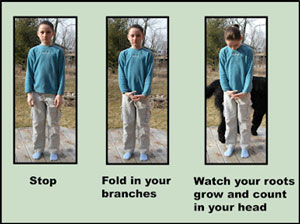Dogs and kids—and trees!
Dogs are stimulated by movement and noise and children are known for their movement and noise! Still, it is possible to work toward and achieve positive and comfortable relationships between dogs and kids.
One of the most valuable skills that children can learn is to stand still and "Be a Tree" if a strange dog comes near them, or if a dog is bothering them or becoming too frisky.
Here is how to "Be a Tree":
- Stop.
- Fold in your branches (hands folded in front).
- Watch your roots grow (look at your feet).
- Count your breaths in your head until help comes or the dog goes away.
"Trees" are boring to dogs. A dog will just sniff at a child/tree and then go away. No matter what the dog does, it is important for the child to stand still, avoid eye contact (by looking down at his/her feet), and stay quiet.
Practice, practice, practice
It is not enough to tell children about being a tree. Kids need to practice the behavior in a low-stress environment in order to have the best chance of recalling the behavior in real-life conditions, particularly if a dog threatens them.
A fun way to emphasize the safety details of the "Be a Tree" behavior is to play the Doggone Crazy! board game. Another way to practice is to engage in role-playing games where players take turns pretending to be a dog. While one player is the dog, other players practice being trees when the dog comes near them. It is also possible to practice "Be a Tree" steps with a stuffed dog (although if you have a puppy or a small dog, you may be able to play with the real dog).
Children practicing "Be a Tree." Notice that as soon
as the children stop moving, the dog loses interest.
In the game, everyone moves around. When the dog (person in the dog role, stuffed dog, or small real dog) comes up, players assume the tree position. The adult in charge of the game should say the dog's name before the dog gets to a child and give the dog a treat (or better still, click and give the dog a treat). In this way, the dog is rewarded for keeping all feet on the ground when the dog is around the kids. A dog will soon learn that when the kids act like trees, no one will move or play anymore. This behavior will be seen as a cue to stop chasing or trying to play.
With a larger dog or a very frisky dog, start the game with the dog on a leash. Approach one of the children in the game. Have that child "be a tree." Say the dog's name, ask the dog to sit, and give a treat. Repeat these steps until the dog looks at you and sits automatically when he sees a kid being a tree.
Remember to keep things calm with the kids during the practice game. It is not a good idea for children to run around and get a dog all riled up.
It works!
Here are some testimonials from people who have had success with the "Be a Tree" model.
Jake jumped back (the dog followed, barking) and Jake snapped into the Tree pose so fast I thought I'd seen him turn to stone. I couldn't believe he actually thought to do it—it had been over a year since we had time to play Doggone Crazy. The dog immediately stopped barking, jumped back into his blankie, and further trouble was thus averted.
—Beth Wheeler, Marblehead MA
One day my [4-year-old] son was outside playing, no dogs were in [sight], I was standing in our doorway watching Thomas play. Suddenly, the back door to the house behind us opened and out flew the dogs. The male spotted Thomas immediately and charged him, clearing the fence easily. Thomas saw this and began to run for me. I yelled immediately for him to STOP and to stand like a "tree." Thankfully, Thomas did both, the dog stopped, looked around, and then headed back over the fence to his own yard. Another call went out to Animal Control, and a big hug to my son.
—Kerry McDonald, Pembroke ON
As an Animal Behaviourist who has testified in numerous court cases as a designated "expert" witness in the field of canine aggression in Ontario, I came across some information relevant to Doggone Safe when reviewing material for a recent case. The parents of a young child credited this program with saving their [3-year-old] daughter's life when she was confronted by a large, aggressive-acting dog. According to [the parents], had they not taught her the principles outlined in the 'Be a Tree' program, the results of their daughter's incident with this dog could have been disastrous. This account should tell you everything you need to know about the efficacy of Doggone Safe.
—Kerry Vinson, Animals Behaviour Consultant, Roseneath ON



